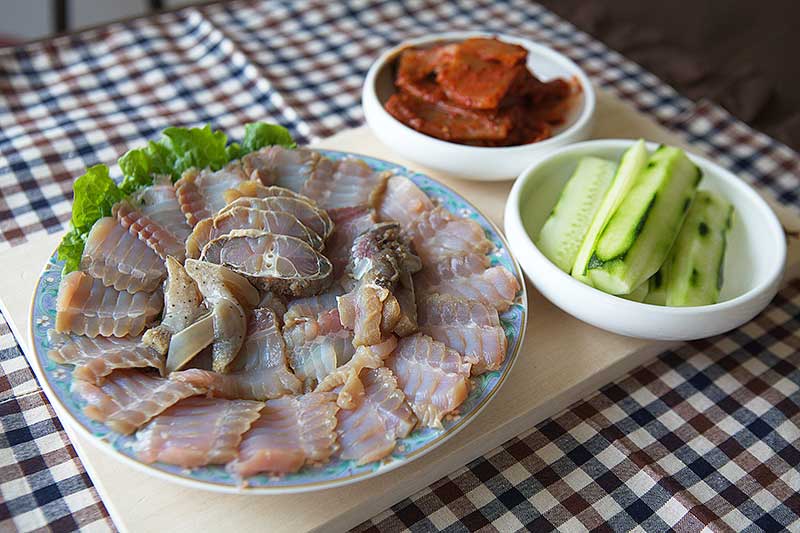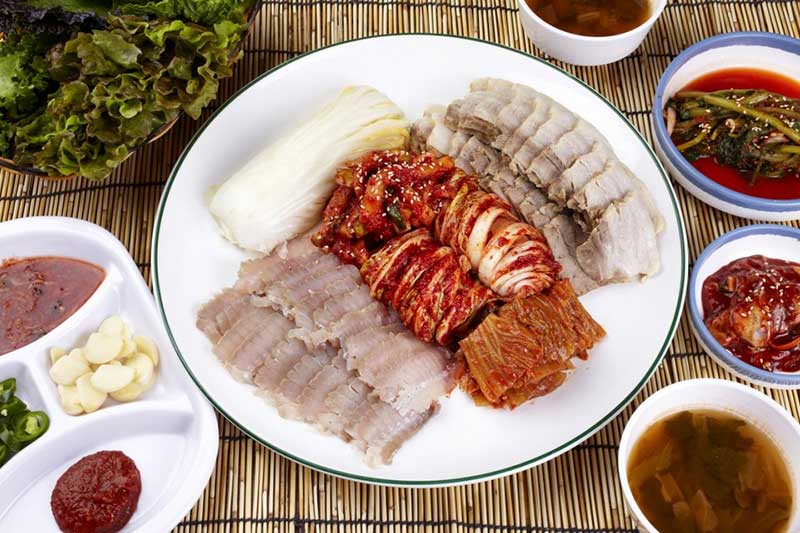Fermented Skate Explained – Korean Delicacy Secrets

If you’re a lover of unique and exotic dishes, then you must try fermented skate. This Korean delicacy has gained popularity worldwide for its distinct and pungent flavor that may be intimidating for some but is guaranteed to leave a lasting impression on your taste buds.
Fermented skate is a type of fish that has been preserved through the process of fermentation. This process involves placing skate in a salted brine for several months until it becomes soft and develops a cheesy aroma. The traditional preparation methods and cultural significance of this dish add to its charm.
If you’re wondering what exactly fermented skate is and why it’s considered a delicacy in Korean cuisine, then read on to discover its fascinating secrets.
Key Takeaways
- Fermented skate is a Korean delicacy with a unique flavor and smell.
- It is a type of fish that undergoes the process of fermentation in salted brine.
- The traditional preparation methods and cultural significance of fermented skate make it an intriguing choice for adventurous eaters.
- Stay tuned to learn more about how the fermentation process turns skate into a delicacy, the potential health benefits of consuming fermented skate, and how to prepare and enjoy it traditionally.
Understanding the Fermentation Process of Skate
Skate fermentation process is a unique and time-honored tradition that’s embedded in the Korean culture. At its core, the fermentation process entails storing freshly caught skate in a cold environment for an extended period (usually weeks) until it develops a strong ammonia-like smell and distinctive flavor. The fermented skate is then served as a delicacy, often in its raw state, as a standalone dish or mixed in with other ingredients.
The process of fermenting skate begins with thorough cleaning and gutting the fish. The skate is then rubbed with liberal amounts of salt before being placed in a cool container to ferment. The salt helps lower the water content of the fish and provides an ideal environment for beneficial bacteria to thrive and induce fermentation. The bacteria in turn secrete enzymes that break down the proteins and cartilage in the fish’s body, resulting in a softer, more tender texture.
The fermentation process can take anywhere from a few days to several weeks, depending on the desired depth of flavor and texture. After the fermentation period, the fish is removed from the container, cleaned and prepared for serving.
The result of the fermentation process is a strong-smelling and pungent fish that’s transformed into a delicacy. Fermented skate is a popular dish in Korea, and its flavor is often described as sour and spicy with a chewy texture. In recent times, the dish has garnered global attention, with food enthusiasts flocking to Korea to experience this unique delicacy.
Overall, the fermentation process plays a vital role in the creation of fermented skate and sets it apart from regular fish. Without this process, skate would not have the unique flavor and texture that make it a sought-after delicacy in Korea and other parts of the world.
Benefits of Eating Fermented Skate
Aside from its unique flavor and texture, fermented skate also offers potential health benefits that make it worth trying.
Nutritional Value of Fermented Skate
Fermented skate is packed with nutrients, making it a healthy addition to any diet. This delicacy is high in protein, low in fat, and rich in vitamins and minerals. It is particularly high in calcium, which is essential for strong bones and teeth.
| Nutrient | Amount per 100g of Fermented Skate |
|---|---|
| Protein | 18g |
| Calcium | 1500mg |
| Vitamin B12 | 450μg |
Benefits of Fermentation
The fermentation process used to prepare skate enhances its nutritional value and may provide additional health benefits. The fermentation process increases the amount of probiotics in skate, which are beneficial bacteria that aid in digestion, boost the immune system, and improve overall gut health.
The probiotics found in fermented skate may also help to reduce inflammation and prevent certain types of cancer.
Specific Health Benefits of Fermented Skate
While research on the health benefits of fermented skate is limited, some studies suggest that consuming it may have positive effects on certain health conditions. For example:
- Skate contains a high concentration of taurine, an amino acid that has been linked to a reduced risk of heart disease and improved cardiovascular health.
- The probiotics found in fermented skate may help to alleviate symptoms of irritable bowel syndrome (IBS) and other digestive disorders.
- Fermented skate may also have antibacterial properties that help to prevent infections and protect against harmful bacteria.
Overall, adding fermented skate to your diet may have significant health benefits that make it a worthwhile delicacy to try.
Traditional Preparation and Enjoyment of Fermented Skate
In Korea, fermented skate is enjoyed in many different ways. One of the most traditional fermented skate dishes is called hongeo-hoe, which is a simple dish of sliced fermented skate served with side dishes like kimchi and rice.
If you’re new to fermented skate, it’s recommended to start with a small portion and work your way up. The distinct flavor and odor may take some getting used to.
Fermented Skate Recipe
Here’s a simple recipe to make fermented skate at home:
- Purchase fresh skate from a fish market.
- Clean the skate thoroughly and remove the internal organs.
- Spread a thick layer of coarse salt on the skate and leave it to dry for several hours or overnight.
- After the drying process, wash off the excess salt and allow the skate to age in a refrigerator for at least a week.
- Once the skate has reached the desired level of fermentation, it’s ready to eat!

Popular Fermented Skate Dishes in Korea
| Dish name | Description |
|---|---|
| Hongeo-hoe | Sliced fermented skate served with side dishes like kimchi and rice. |
| Hongeo-muchim | Thinly sliced, seasoned fermented skate mixed with vegetables such as onions and peppers. Served cold as a side dish. |
| Hongeo-jeongol | A stew made with fermented skate, vegetables, and a spicy broth. |
These dishes all highlight the unique and savory flavor of fermented skate, and have been enjoyed by Koreans for generations.
Conclusion
Overall, fermented skate is a unique and fascinating Korean delicacy that has captured the attention of food enthusiasts around the world. While this dish offers many potential health benefits, there are also some side effects to keep in mind.
Consuming fermented skate can lead to a strong, pungent odor that may be unpleasant to some individuals. Additionally, the high levels of ammonia produced during the fermentation process can cause skin and eye irritation for some individuals, particularly those with asthma or other respiratory conditions.
Despite these potential side effects, fermented skate remains a beloved delicacy in Korean cuisine, with a rich cultural history and tradition. For those willing to try it, there are many delicious recipes and dishes that incorporate fermented skate, making it a truly unique culinary experience.
FAQ
What is fermented skate?
Fermented skate is a traditional Korean dish made by fermenting the cartilaginous fish known as skate. It involves burying the fish in layers of salt and allowing it to ferment for several weeks. The fermentation process breaks down the proteins in the skate, resulting in a pungent odor and a unique taste.
What is the skate fermentation process?
The skate fermentation process starts by cleaning the fish thoroughly and removing any impurities. Next, the fish is covered in layers of salt to draw out excess moisture and assist in the fermentation process. The salted skate is then aged for several weeks to allow the flavors to develop and intensify. The end result is a pungent, distinctive delicacy.
What are the benefits of eating fermented skate?
Fermented skate is believed to offer various health benefits. It is a good source of protein, vitamins, and minerals, including calcium and phosphorus. The fermentation process also enhances the nutritional properties of skate, making it easier to digest. Additionally, some studies suggest that fermented skate may have antibacterial and anti-inflammatory properties.
How is fermented skate traditionally prepared?
Fermented skate is traditionally prepared by cleaning the skate thoroughly, removing the skin and entrails. The fish is then layered with coarse sea salt and left to ferment for several weeks. After the fermentation process, the skate is washed to remove excess salt, sliced, and served alongside various condiments such as kimchi, garlic, and chili paste.
Can I prepare fermented skate at home?
Yes, it is possible to prepare fermented skate at home. However, it is a time-consuming and complex process that requires careful attention to hygiene and safety. It is recommended to seek guidance from experienced individuals or consult authentic recipes to ensure proper fermentation and safe consumption.
Are there any side effects or considerations when consuming fermented skate?
Yes, there are some considerations when consuming fermented skate. The strong smell and taste of fermented skate may be overpowering for some individuals, and it is an acquired taste. Additionally, the fermentation process can produce ammonia-like compounds, which may cause digestive discomfort in sensitive individuals. It is advisable to consume fermented skate in moderation and consult a healthcare professional if you have any concerns.